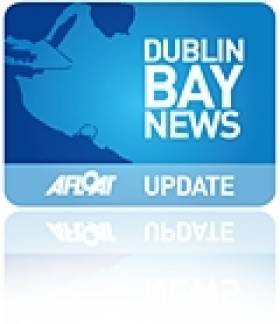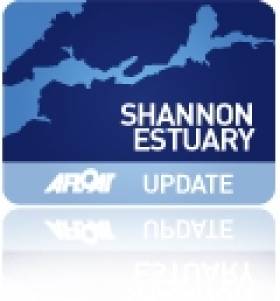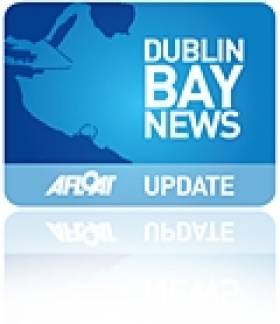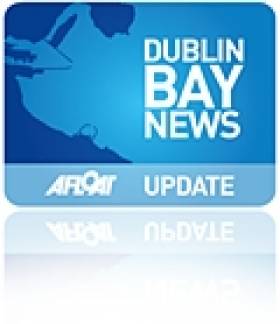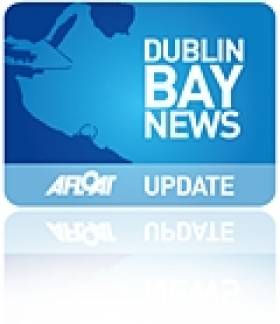Displaying items by tag: Masterplan
Shannon Foynes Port Company which is Ireland’s second largest port operator, has said that the Shannon Estuary Vision 2041 Masterplan needs to start now.
That’s the view of the Port's CEO Pat Keating on the masterplan which the Minister for the Environment, Eamon Ryan recently launched to highlight the unique strategic location in Ireland and Europe, to develop floating offshore wind projects in the Atlantic.
The masterplan for the Shannon estuary, a 500km2 waterway stretching from Limerick City to Loop Head in Co. Clare, is on course to become an international floating offshore wind energy hub in addition to helping the country reach its climate goals.
According to Mr Keating the masterplan will lead to significant economic impacts in the region aswell to thousands of jobs created. The project is a multi-site approach he added and with strategic development locations across Kerry, that also included opportunities at the Port of Fenit.
The story from RadioKerry includes an audio clip of the CEO commenting on the potential of renewable projects for the estuary and also along the western seaboard.
On the southern tip of County Kilkenny is located the Port of Waterford which is beginning a public consultation process seeking inputs from all stakeholders on a proposed master plan setting out how the port could develop over the 25-year period to 2044.
As the Kilkenny People writes, the port company's draft masterplan outlines various demand scenarios that will determine capacity requirements at the port. The intention is that the masterplan will provide a framework for development and position the port to respond to emerging trends and opportunities.
The first consultation sessions will be held on the 4th floor of the Marine Point office development in Belview, County Kilkenny at 11:00 and 14:30 on Wednesday, 26 June.
A further session will be held in the Passage East/Cheekpoint area of County Waterford on 18 July with the time and venue to be posted on the port’s website once confirmed.
Click here for more on the master plan.
Dun Laoghaire Harbour Chief Lodges High Court Action Against Company
#DunLaoghaire - Dun Laoghaire Harbour Company chief executive Gerry Dunne has lodged High Court proceedings against his employer, according to Sunday Business Post business correspondent Jack Horgan-Jones in yesterday’s edition of the paper.
Dunne, who was appointed CEO in 2009, spearheaded the ‘masterplan’ for regeneration of the south Dublin harbour that has in recent years lost its long-time passenger ferry link to Britain.
Under Dunne’s oversight, plans for the harbour have included a now-cancelled diaspora centre, an ‘urban beach’ project that received planning permission in mid 2015 but was not realised as expected this summer, and a new cruise terminal to accommodate next-generation liners that was at the centre of oral hearings last year.
More recently, the possibility of hosting a floating hotel or ‘flotel’ in the harbour has been mooted.
However, Horgan-Jones writes that these ambitious projects have been subject to “reservations at the highest level of government”, with one civil servant raising concerns about the soundness of the harbour’s corporate plan.
In response to our request for comment, Dunne said that the precise matter of the High Court action is currently sub judice.
Dun Laoghaire Harbour Masterplan Shortlisted for Prestigious Award for Planning Excellence
#dlmasterplan – Dun Laoghaire Harbour Masterplan has been shortlisted in the 'Excellence in Planning to Create Economically Successful Places' category at the 2015 Planning Awards for Excellence. The Awards, run by the Royal Town Planning Institute (RTPI) will be held at the Pullman London St Pancras Monday, 6th July 2015.
The Dun Laoghaire Harbour Masterplan was published in 2011 following extensive consultation with harbour stakeholders. The plan seeks to extend the recreational and amenity value of the harbour; to promote investment; and to generate sufficient revenue from commercial operations to ensure the sustainability of the maintenance programme and marine facility that the harbour provides. In short, the objective is to transform the harbour into a living, vibrant area, offering facilities for people to live, work and relax. The Masterplan envisages development over a 15 - 20 year period. It will be reviewed every five years.
Gerry Dunne, the CEO of Dun Laoghaire Harbour Company said today: "I am delighted that our Masterplan has been nominated for such a prestigious award. A huge amount of work was put into the drafting of the Masterplan which aims to transform the harbour into a living, vibrant area for people to live work and relax, while at the same time preserving the unique character that has made the harbour such an amenity over decades.
"The nomination comes at a time when we are in the midst of a public consultation process on one of the key proposals in the Masterplan – the development of a new cruise ship berth facility, to enable the harbour to cater for new, larger cruise ships. This will be a great boost for all those who want to see Dun Laoghaire Harbour thrive", Mr. Dunne said
The RTPI represents 23,000 planning professionals worldwide and promotes spatial planning, shapes policy and raises professional standards. The Awards for Planning Excellence have been run by the RTPI for over 30 years to recognise planning excellence.
This year's headline sponsor is AECOM with other sponsors and supporters including Bilfinger GVA, The Planner, Planning Aid England and the Royal Borough of Kensington and Chelsea.
Janet Askew, President of the Royal Town Planning Institute said: "The shortlist reflects the very best planning projects, strategies and processes that are helping to make great places for people to live and work. The 80 finalists highlight exceptional examples of planning that have made an impact and brought considerable benefits. It will be a tremendous challenge picking individual category winners from such a high quality field."
Andrew Jones, Practice Leader for Design, Planning + Economics, EMEA at AECOM said:
"AECOM is proud to be this year's headline sponsor of the RTPI's Awards for Planning Excellence. The shortlist is a diverse mixture of outstanding examples of planning, which really demonstrate the impact the profession has on quality and delivery in the built environment. We look forward to seeing which entries the judges select as the category winners."
Projects on the shortlist have been recognised for their national contribution to planning and demonstrate how significant schemes can be delivered speedily through the planning and other consents systems.
Master Plan for Shannon Estuary Launched
#Shannon - The Shannon Foynes Port Company has launched its master plan for the development of port infrastructure and services along the Shannon Estuary.
RTÉ News reports on the 30-year plan, titled Vision 2041, which will involve the construction of a new deepwater birth at Foynes, the development of warehousing and facilities across 300 acres of additional land - and the potential reopening of the Foynes-Limerick railway line, which has lain dormant since 2001.
As one of the deepest waterways in Europe, the estuary is also in prime position to take advantage of the new 'post-panamax' supertanker shipping era, and talks on securing future foreign direct investment as a priority.
As previously reported on Afloat.ie, submissions for the accompanying strategic plan for the development and management of marine-related industry and tourism in the Shannon Estuary region closed last week.
The Draft Strategic Integrated Framework Plan (SIFP) for the Shannon Estuary, the first of its type to be developed in Ireland, identifies a number of strategic sites along the estuary for future possible development in the areas of industry, tourism, energy, fishing and aquaculture and marine-related industry.
Dun Laoghaire Makes Case Abroad For Diaspora Centre
#DunLaoghaire - Dun Laoghaire Harbour Company chief executive Gerry Dunne made the case for a diapora centre in the South Dublin port town at a gathering in the House of Lords in London recently.
The meeting was hosted by Baroness Detta O’Cathain, a member of the leadership council of the Irish International Diaspora Trust which is working to create a diaspora centre at Dún Laoghaire Harbour.
In an opinion piece published in The Irish Times a few weeks ago, Baroness O'Cathain wrote that "by supporting the creation of a disapora centre... we will be paying tribute to our ancestors."
The proposed Irish International Diaspora Centre forms part of the Masterplan for Dun Laoghaire Harbour, which will involve an investment of more than €230 million over the next 10-15 years.
The €50 million diaspora visitor centre envisaged for Carlisle Pier would celebrate the “origins, diversity and influence of the Irish at home and abroad” at a place where thousands of Irish people left for new lives in Britain and beyond in decades past.
Baroness O'Cathain said she was pleased that the Programme for Government "seeks to support the creation of a diaspora centre", adding that "we must pass on to this generation and to future generations the importance of the Irish DNA of the soul.
"The sense of belonging to a very precious country brightens our lives. This is what, in strong terms, the diaspora centre will do."
Last summer The Irish Times reported that Peter Whittaker of Martello Media was been appointed creative director of the Irish International Diaspora Centre development team.
Dun Laoghaire Harbour Tenders for 'Marina Village' Design Proposals
#DunLaoghaire - The Dun Laoghaire Harbour Company has issued a tender for a design team to draft a vision for the proposed 'Marina Village Project' in the port town.
The Marina Village development is on the site of the former Shell Chemicals facility at the West Pier next to the Dun Laoghaire Motor Yacht Club, at an area known as the 'Gut'.
It is also part of the Masterplan launched in mid-2011 intended to "position Dun Laoghaire Harbour as a marine, leisure and tourism destination of international calibre".
As per the Masterplan, the development is intended for residential and water-sports use, and the aim of this tender us to "identify the optimum development proposition for the site".
The tender document suggests that proposed water-sports facilities at the site "could potentially be occupied by users such as the Sea Scouts".
In their joint response to the launch of the Masterplan in June 2011, Dun Laoghaire's yacht clubs identified a "significant amount of shore space" ripe for development in the area earmarked for the Marina Village scheme.
The request for proposals is available to download as a PDF below.
Artist's Impression Shows Future for Dun Laoghaire Harbour
#DUN LAOGHAIRE – An artist's impression of a regenerated Dun Laoghaire harbour showing two new harbour marinas, berthing for tall ships, a dramatic canopy building on the Carlisle pier plus extensive development of the waterfront in front of the yacht clubs is on display at the town's East pier.
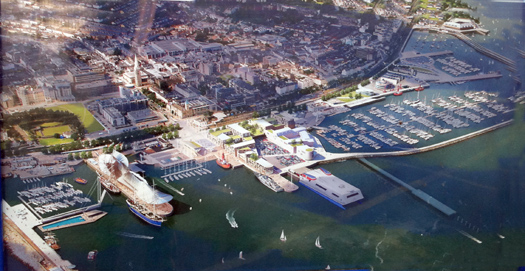
The artist's impression showing the new waterfront at Dun Laoghaire Harbour
The poster forms part of the notice of the adoption of the Dun Laoghaire Harbour masterplan under an EU Directive.
"The Masterplan will position Dun Laoghaire Harbour as a marine, leisure and tourism destination of international calibre", said Gerry Dunne, Chief Executive Officer, Dun Laoghaire Harbour Board.
The Masterplan will involve investment of more than €230m, over the next 10-15 years and will result in 1000 sustainable jobs in areas such as tourism, marine service companies, select retail, and food and beverage.

The area at the East pier showing a new sea water baths scheduled to open shortly, a new marina in front of the National Yacht Club, Tall Ship berthing and a new canopy on the Carlisle Pier

An extended plaza area (above) and new waterfront buildings and a Coal harbour marina at the West Pier (below)
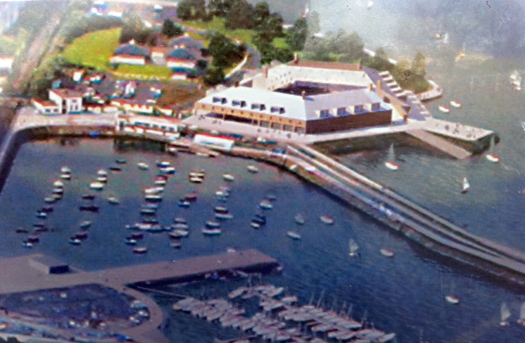
Dun Laoghaire Yacht Clubs Voice Concern Over Plan
Dun Laoghaire Yacht Clubs are voicing concerns about the impact on sailing if a 'cruise ship jetty' is constructed as part of the recently published harbour masterplan.
Dublin Bay Sailing Club, Dun Laoghaire Motor Yacht Club, National Yacht Club, Royal Alfred Yacht Club
Royal Irish Yacht Club and Royal St George Yacht Club. are also concerned about access to the water if a proposed 'pedestrian walkway' in front of the waterfront clubs was completed.
The clubs have engaged 'professional help' to prepare a submission to outine the concerns.
Also seen as a problem is the 'lack of sufficient facilities in the masterplan for hosting significant international sailing events'.
A survey in 2009 by the Irish Marine Federation (IMF) calculated a €3million spend by participants connected with the 500-boat Volvo Dun Laoghaire regatta. The clubs have previously stated they see the harbour's future as a leisure facility.
A masterplan model was on display by the Harbour Company in the month of August.
Writing to members in the current edition of the National Yacht Club's newsletter commodore Paul Barrington says the clubs 'hope to further engage with the harbour [company] to find a mutually acceptable way forward'.
Water Rat: Harbour Plan is a Curate's Egg
Today's Irish Times editorial raises questions over the new 'masterplan' for Dun Laoghaire harbour.
As previously reported on Afloat.ie, the plan is intended to position Dun Laoghaire "as a marine, leisure and tourism destination of international calibre".
But The Irish Times says: "[The] company needs to reassure the public that all of the proposed uses can be safely accommodated within the granite enclosing arms of this great harbour, without conflicting with each other.
"Is it realistic, for example, to have greatly expanded facilities for sailing and at the same time provide berthing for very large 'next generation' cruise liners? How realistic is the plan to develop 300 apartments within the harbour area in the current market?"
Doubts are also raised about the feasibility of Dublin hosting two cruise liner facilities if plans to expand Dublin Port get the go-ahead.
The Irish Times website has more on the story HERE. The Dun Laoghaire Yacht Club's joint response to the masterplan is HERE




























